Papers by Jacek Antonkiewicz
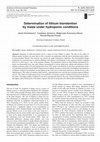
Archives of Environmental Protection, 2017
Irrigation of cultivated plants can be a source of toxic lithium to plants. The data on the effec... more Irrigation of cultivated plants can be a source of toxic lithium to plants. The data on the effect of lithium uptake on plants are scant, that is why a research was undertaken with the aim to determine maize ability to bioaccumulate lithium. The research was carried out under hydroponic conditions. The experimental design comprised 10 concentrations in solution differing with lithium concentrations in the aqueous solution (ranging from 0.0 to 256.0 mg Li ∙ dm-3 of the nutrient solution). The parameters based on which lithium bioretention by maize was determined were: the yield, lithium concentration in various plant parts, uptake and utilization of this element, tolerance index (TI) and translocation factor (TF), metal concentrations in the above-ground parts index (CI) and bioaccumulation factor (BAF). Depression in yielding of maize occurred only at the highest concentrations of lithium. Lithium concentration was the highest in the roots, lower in the stems and leaves, and the low...
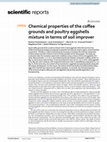
Scientific Reports, 2022
Spent coffee grounds (SCG) as well as chicken (CES) or duck eggshells (DES) left over from the ar... more Spent coffee grounds (SCG) as well as chicken (CES) or duck eggshells (DES) left over from the artificial hatching technology are proposed as potential soil improver and/or organic-mineral fertiliser components. Therefore, it seems interesting and necessary to evaluate the chemical composition of these wastes and their mixtures in terms of their possible use for that purpose. The study was conducted under the incubation experiment conditions using a mixture of SCG and eggshells (10:1 ratio). Macronutrients, i.e. C, N, S, were determined by the catalytic combustion method, while P, K, Mg, Ca, Na by atomic spectrometry. It was found that SCG were rich in C, N, P, and K, while eggshells in Ca, Mg, Na, and S. However, CES compared to DES were richer in deacidifying components (i.e. Ca, Mg, K). At the same time, the content of macronutrients in eggshells decreased gradually along with the embryo development. For this reason, the mixture of SCG and shells of unembryonated chicken eggs (CE...
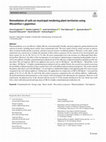
Environmental Science and Pollution Research
Phytoremediation, as a cost-effective, highly efficient, environmentally friendly, and green appr... more Phytoremediation, as a cost-effective, highly efficient, environmentally friendly, and green approach, gained attention to the removal of metals, including heavy metals, from contaminated soils. The toxic nature of heavy metals can have an adverse effect on human health and the ecosystem, and their removal remains a worldwide problem. Therefore, in this study, a field experiment was carried out to evaluate the potential of Miscanthus × giganteus for the removal of ten microelements and heavy metals (Al, Zn, Fe, Pb, Cd, Co, Cr, Cu, Mn, Ni) from contaminated soil in the territory of a Municipal Waste Rendering Plant. Moreover, the effect of the incorporation of soil improver obtained upon composting biodegradable waste as well as the addition of highly contaminated post-industrial soil on the efficiency of phytoremediation and plant growth was described. The soil improver (SK-8) was applied to the soil at a rate of 200 Mg ha−1 and 400 Mg‧ha−1. Meanwhile, in the last object, 100 Mg‧ha−...
Chemosphere, Aug 1, 2019
Levels of PAH and HM contaminants is linked to town size, industry and population. PAH and HM con... more Levels of PAH and HM contaminants is linked to town size, industry and population. PAH and HM concentrations followed an order: central area > urban area > green area. Major PAH and HM sources in a large town Krakow were traffic emissions. PAHs and HMs in Zakopane were emitted from domestic coal and wood combustion ovens. Carcinogenic PAH levels exceeded the safe value in some soils of central Krakow.
Smart innovation, systems and technologies, 2022
ČZU v Praze. Katedra agroenvironmentální chemie a výživy rostlin, 2012

A large percentage of light soils and the need for improving their physicochemical properties as ... more A large percentage of light soils and the need for improving their physicochemical properties as well as reduced production of natural fertilizers as a result of a dwindling number of farm animals are the main factors speaking in favor of agricultural application of municipal sewage sludge in Poland. Sewage sludge contains substantial amounts of organic matter and nutrients which are needed by plants, in amounts close to manure. For these reasons, it should be used environmentally. Increasing requirements with respect to environmental protection bring about the necessity to use organic waste for fertilization. The municipal sewage sludge was applied under spring barley cultivated on heavy soil with neutral reaction. The content of assimilable components in that soil was at a low level, and the amount of heavy metals did not exceed acceptable values. After application of municipal sewage sludge in a dose of 5.34 Mg d.m./ha (which corresponded to 24 t fresh matter), favorable changes in soil physicochemical properties were determined. We observed an increase in soil richness in organic carbon, total nitrogen as well as an increase in the level of assimilable macroelements. The chemical analysis of the plant material showed that spring barley fertilized with sewage sludge contained more macronutrients, which increased its fodder value. The research showed that municipal sewage sludge increased the uptake of macronutrients.

Advances in Tourism, Technology and Systems, 2020
This study addresses a road-map on how information technologies can be used to enhance the safe c... more This study addresses a road-map on how information technologies can be used to enhance the safe cultural heritage experience throughout the visitors’ journey time within integrated health green ecotourism sustainable infrastructures and associated agritourism facilities for particular activities in space. As its main contribution, it presents a model of information communication technology to enhance effective project management for sustainable fast applied construction designs for environmental - public health protection and safe cultural heritage experience for tourists at ecological landscapes, forests and sea shore, coastal destinations. In the examining application of relative web project management technologies it is not limited to the onsite stage of the cultural experience, but is extended also to the integrated educational agri-tourism and ecotourism travel destinations for all stakeholders. The examining presented roadmap at a cultural heritage site provides insights into the opportunities to use a combination of applications in rehabilitation projects for enriching and facilitating the cultural visit in terms of a healthy environment with cultural, heritage life for renewable energy consumption from biofuels, wastewater units, landfill design emissions units. Also qualitative food, drink production activities should be promoted that are improving human health, promoting biological agricultural products, gastronomic healthy ones and biological drinks at the destination according to an extended, multi-stage perspective of the gastronomic heritage experience for all ages. In this way integrated green health tourism infrastructures and reclamation works are necessary for different ages and interests of tourists.
Acta Biologica Cracoviensia. Series Botanica. Supplement, 2014
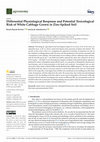
Agronomy
Physiological, agricultural and toxicological impact of an excess of Zn in the soil is an importa... more Physiological, agricultural and toxicological impact of an excess of Zn in the soil is an important issue, as Zn is a heavy metal and impairs many processes of plants and animals. The novelty of this work is that it is a comprehensive approach to facilitate visualization not only of the condition of cabbage plants under Zn stress, but also prediction of the toxicity associated with consumption of such cabbages. We treated plants of two cabbage cultivars, differing in their earliness, with 50 and 200 mg Zn kg−1 soil (Zn50 and Zn200, respectively) above the natural Zn levels of 118.13 mg kg−1 soil (Zn0). Leaf cell membrane integrity, condition of the photosynthetic apparatus (reflected by relative chlorophyll content (SPAD) and Fv/Fm parameter of chlorophyll a fluorescence), head biomass, and Zn bioaccumulation in the heads were analyzed. Toxicological risk was also assessed by Daily Intake of Metal (DIM) and Health Risk Index (HRI) indicators. The data revealed that plants of the lat...
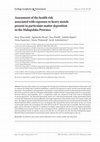
Geology, Geophysics and Environment, 2021
The aim of the study was to investigate the content of trace elements in deposited particulate ma... more The aim of the study was to investigate the content of trace elements in deposited particulate matter and to estimate the health risk to Kraków inhabitants, caused by the exposure to heavy metals in particulate matter deposition. The qualitative and quantitative assessments of selected heavy metals in deposited particulate matter have been carried out in the city of Kraków (Małopolska, southern Poland, 5 measuring points) for seven months, between February and September 2017. A comparative study was conducted at the same time in Małopolska (5 measuring points). The deposited particulate matter was collected gravitationally, using measurement plates covered with aluminum foil and paraffin jelly. The largest deposition of particulate matter was found in May and June. The highest amount of deposited particulate matter and metals present in it was determined in Kraków. The Hazard Quotient (HQ) evaluation for non-carcinogenic effect showed low risk for each metal. In the case of lead in ...
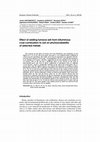
The research on the effect of furnace ash from bituminous coal combustion on the uptake of Cr, Cu... more The research on the effect of furnace ash from bituminous coal combustion on the uptake of Cr, Cu, Ni, Fe, Mn, Al by maize (Zea mays L.) was conducted under conditions of a three-year pot experiment. The arable soil in the pot experiment was amended with furnace ash in the amount of 23.33 g·pot-1 (corresponding to 20 t·ha-1) and with increasing doses of cadmium (3÷15 mg·kg-1 soil DM). Application of ash and cadmium in the amount of 3÷5 mg·kg-1 DM to the soil had a significant effect on the increase in the yield of above-ground parts and roots of maize. Application of subsequent doses of cadmium (7.5÷15 mg·kg-1) caused a considerable reduction in the yield of the tested plant. The research shows that the applied furnace ash reduced the depression in yielding of maize. Introduction of furnace ash to cadmium-contaminated soil caused an increase in the content of Cr, Fe, Ni, Cu and Al in maize biomass and a decrease in the content of Mn in maize. Among the studied metals, Mn was translocated from roots to above-ground parts the most efficiently, and Al-the least efficiently, evidence of which are the highest values of the translocation factor for Mn, and the lowest values for Al. The research showed that ash introduced to cadmium-contaminated soil did not immobilize the above-mentioned metals, and thereby did not reduce the phytoavailability. In general, contamination of the soil with cadmium and introduction of ash stimulated uptake of the metals by maize. We observed that roots took up more Cr, Fe, Ni and Al, whereas above-ground parts of maize took up more Mn and Cu. The lowest uptake of the studied metals by maize was observed in the treatment where only furnace ash was applied.
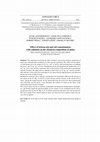
Agronomy Science, 2019
The experiment concerning the effect of furnace waste on the chemical composition of maize was co... more The experiment concerning the effect of furnace waste on the chemical composition of maize was conducted under conditions of a three-year pot experiment. The arable soil was amended with bottom ash in the amount of 23.33 g ∙ pot-1 as well as with increasing doses of cadmium (between 3 and 15 mg ∙ kg-1 soil d.m.). Introduction of ash and cadmium in the amount from 3 to 5 mg ∙ kg-1 d.m. to the soil had a significant effect on the increase of the yield of above-ground parts and roots of maize. The application of cadmium in doses from 7 to 15 mg ∙ kg-1 caused a considerable reduction in the yield of the tested plant. It was shown that the applied furnace ash influenced the decrease in the yielding of maize. Introduction of furnace ash to cadmium contaminated soil significantly influenced the increase in the content of Na, K, Mg, Ca and Si in maize biomass and the decrease in the content of P in maize. Among the studied elements, K was translocated from the roots to the above-ground part...
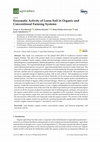
Agriculture, 2020
This study was conducted over the period 2017–2019 in Czesławice (central Lublin region, Poland).... more This study was conducted over the period 2017–2019 in Czesławice (central Lublin region, Poland). The aim of the present study was to compare chemical soil quality parameters (soil pH, available P and K, organic carbon, and total nitrogen content) and soil enzymatic activity (dehydrogenase, acid phosphatase, alkaline phosphatase, urease, protease) in organic and conventional farming systems. The experimental design included two crop rotations (organic and conventional) in which identical plant species were grown: sugar beet-spring barley-red clover-winter wheat-oats. The loess soil on which the experiment was conducted was characterized by the grain size distribution of silt loam, and this soil was categorized as good wheat soil complex (soil class II). The experiment was set up as a split-plot design in triplicate in plots with an area of 40 m2. Soil sampling was carried out using a soil auger within an area of 0.20 m2 (from the 0 to 20 cm layer) in each plot during the autumn peri...
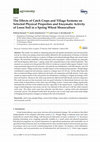
Agronomy, 2020
This study was aimed at comparing physical soil quality parameters and soil enzymatic activity in... more This study was aimed at comparing physical soil quality parameters and soil enzymatic activity in a three-year spring wheat monoculture affected by the incorporation of biomass of selected catch crops into the soil using two systems of tillage (conventional plough tillage and conservation tillage). We tested the suitability of the following catch crop plants: white mustard, lacy phacelia, and mixed legumes (faba bean + spring vetch) and compared these to the control treatment. This research was carried out in the period 2014–2016 in Czesławice (central Lublin region, Poland). Catch crops promoted improved soil structure, soil particle-size distribution, soil bulk density, and soil moisture content. Tillage systems had a smaller impact on the soil physical parameters. Plough tillage contributed to improved soil moisture content in a deeper layer (15–20 cm). On the other hand, the above-mentioned tillage system influenced adversely soil compaction and bulk density. Catch crops caused ...
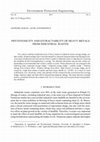
Environment Protection Engineering, 2017
The content, mobility and phytotoxicity of heavy metals in industrial wastes (sewage sludge, carb... more The content, mobility and phytotoxicity of heavy metals in industrial wastes (sewage sludge, carbide residue, flotation tailings) have been determined by chemical characterization and biological test. Assessment of phytotoxicity and content of heavy metals in industrial wastes is important for screening the suitability for their land application or storage. The obtained information may provide a better understanding of environmental risks of heavy metals in wastes. Waste phytotoxicity was arranged in the following order: municipal sewage sludge > industrial sewage sludge > carbide residue > flotation tailings from Żelazny Most > flotation tailings from Gilów. High toxicity of sewage sludge can be caused by a high total content of metals and their forms soluble in 1 M HCl. As a result of waste acidification, zinc, chromium, nickel, and cadmium will be released into the environment from sewage sludge, whereas copper and lead will be released from flotation tailings. The study showed a strongly positive correlation between the content of Zn, Ni, Cr, Cd in waste and root growth and seed germination inhibition.
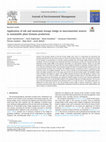
Journal of Environmental Management, 2020
Owing to the growing volumes of ash and sewage sludge waste, there is a requirement for theoretic... more Owing to the growing volumes of ash and sewage sludge waste, there is a requirement for theoretical and practical research into the use of these wastes as a source of nutrients. However, there are relatively few studies on the transfer of macronutrients in soil-plant systems amended with ash-sewage sludge mixtures under field conditions. The aim of the study was to determine the effect of bituminous coal ash (AC), biomass ash (AB), and municipal sewage sludge (MSS) on the quantity and quality of a grass-legume mixture. During a 6 year field experiment on a sandy loam soil treated with the wastes, applied as mixtures or separately, the plant yield; N, P, K, Na, Mg, and Ca uptake by plants; macronutrient content and ratios in the plant biomass; and the recovery rate of macronutrients by plants were evaluated. The AB-MSS treatment increased the yield in comparison to that where the wastes were applied separately. The N, P, and Ca contents in the plant biomass and N and P uptake under ash-sludge treatments were in the range observed for the ash and sewage sludge. The AB-MSS co-application resulted in the highest K uptake. The AC-MSS treatment increased K and Mg uptake in relation to AC treatment. When AC or AB was added to the MSS, the Ca uptake increased relative to the MSS treatment. The plant biomass under the AB treatment was optimal for biofuel purposes in terms of the chemical composition. The co-application of AC or AB with MSS resulted in the optimum Ca:Mg ratio for fodder purposes. The recovery rate of the macroelements decreased in the following order: K, N, P, Mg, Na, and Ca. The results support the coapplication of solid wastes such as ash and municipal sewage sludge to improve productivity, support the recycling of macronutrients, improve sustainability through the reduction of ash and sewage sludge disposal, and reduce reliance on mineral fertilizer.
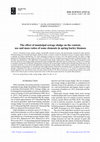
Soil Science Annual, 2017
Municipal sewage sludge contains considerable amounts of macro and microelements essential for pl... more Municipal sewage sludge contains considerable amounts of macro and microelements essential for plant nutrition. With decreasing use of natural and organic fertilizers, there is a need to search for alternative sources of organic matter (which is a substrate for humus reproduction). In a field experiment carried out on heavy soil with neutral reaction, the effect of single application of municipal sewage sludge in a dose of 5.34 Mg·ha−1 DM was compared to an equivalent dose of mineral fertilizers. The test plant was spring barley. After application of municipal sewage sludge, slight positive changes in the chemical properties of the soil were observed. The sewage sludge increased the yield of spring barley grain and straw by, respectively, 14 and 13% in relation to treatment with mineral fertilization. Spring barley fertilized with sewage sludge contained more elements than barley grown only on mineral fertilizers. It was shown that application of municipal sewage sludge to the soil ...
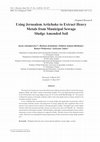
Polish Journal of Environmental Studies, 2018
The aim of our research was to assess the effectiveness of phytoextraction of heavy metals from s... more The aim of our research was to assess the effectiveness of phytoextraction of heavy metals from sewage sludge by 'Rubik' and 'Albik' varieties of Jerusalem artichoke. The 6-year field experiment involved four levels of fertilization with sewage sludge at doses of 0, 10, 20, 40, and 60 Mg DM sludge • ha-1. The research evaluated the amount of Jerusalem artichoke yield as well as the uptake and use of heavy metals by the Jerusalem artichoke varieties. It was established that increasing doses of sewage sludge had significantly increased the yield of the Jerusalem artichoke varieties. Increasing doses of sewage sludge also had a significant effect on the increase in the content of heavy metals in aboveground parts of plants. The highest heavy metal uptake with the yield of the Jerusalem artichoke varieties was observed at a dose of 60 Mg DM • ha-1. Among the tested varieties of Jerusalem artichoke, Albik had higher yield, higher content and uptake of heavy metals, and greater recovery of these elements as compared to Rubik. Therefore, based on the obtained research results, Albik can be recommended for phytosequestration of heavy metals from sewage sludge amended soil.
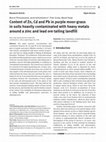
Open Chemistry, 2018
The paper presents concentrations and correlations between Zn, Cd and Pb in the aboveground parts... more The paper presents concentrations and correlations between Zn, Cd and Pb in the aboveground parts of purple moor-grass (Molinia caerulea L.) in forest soils heavily contaminated with heavy metals around a zinc and lead ore tailing landfill at Mining & Metallurgy Enterprise “Bolesław” SA in Bukowno. Field observations have indicated that purple moor-grass, which occurs as one of the few vascular plants in locations with tailing mud, is probably a species with high adaptability to conditions in contaminated environments. The research was carried out in a network of 20 regular monitoring sites. At these sites, a detailed inventory of purple moor-grass was carried out and samples of the aboveground parts of the plants were collected from the leaves and ears and from the soil at a depth of 0-20 cm. It was found that there was no significant correlation between the concentration of heavy metals in the soils and aboveground parts of the plants in the most heavily contaminated zones. This m...

Uploads
Papers by Jacek Antonkiewicz
of leaves of white cabbage (Brassica oleracea var. capitata) grown in
the soil spiked with Zn and Cd for phytoremediation purposes. A
large complexity of antioxidant defense was revealed. SOD, CAT
and APX activities increased, remained unchanged or decreased
depending on the enzyme, the metal and its concentration, and
even on the base for recalculation (fresh weight or protein). In general,
Zn used in the higher dose caused stronger effects than in
the lower one, while in the case of cadmium the relationship was
reversed. The accumulation of both metals in the heads was high
and dose-dependent.